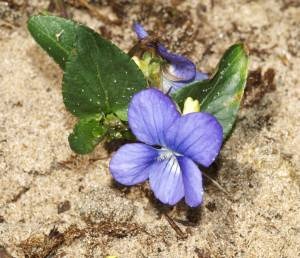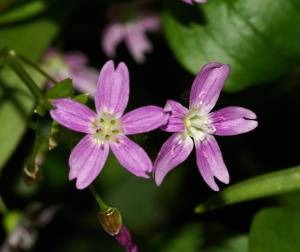Dr Phil Smith’s Wildlife Notes
April 2007
Spring has certainly sprung, with weeks of sunny, often warm and dry weather – too dry for some of our wildlife, especially the Natterjack Toad which likes it damp and needs water for breeding. Many of the dune-slacks are already drying up but my first monitoring visit to Birkdale Green Beach on 14th April was rewarded with a good count of 64 spawn strings. Most will soon be lost to the drought but that is not unusual. The Natterjack chooses such shallow water in which to spawn that it only breeds really successfully about one year in four or five. Its tadpoles need high water temperatures to develop, hence the need for shallow water which warms up quickly in the sun.
Lots of insects have come out earlier than usual, including two of our nationally rare species, the Vernal Bee and the Northern Dune Tiger Beetle. A bit like a small Honey Bee, the Vernal Bee is active from late March to early May, the female collecting pollen from Creeping Willow catkins and storing it in tunnels dug into south-facing dune slopes. As is the case in most bees, this species is “solitary” in contrast to the Bumble Bees and Honey Bees which are truly social insects. In practice, Vernal Bees lives in loose colonies, sometimes numbering into the hundreds and are widespread on the Sefton Coast from Crosby Coastal Park to Queen’s Jubilee Nature Trail.
We have nearly the entire British population of the Northern Dune Tiger Beetle, its only other locality being at Drigg in Cumbria. Ferocious predators, the purplish-brown adults start emerging in April and need very high temperatures for their active life-style. You can find them running about and flying short distances on patches of bare sand in the dunes near the sea – but only on sunny days. I counted as many as nine together in one blow-out at Ainsdale Local Nature Reserve on 19th April.
Another interesting sighting the following day at Birkdale Green Beach was of two male Ruby Tiger moths fluttering around a female, half hidden in the grass. Like many moths, the female emits a chemical scent or pheromone which attracts males over considerable distances. But, although this is a fairly common dune species, I have never seen this behaviour before in Ruby Tiger.

Duneland flowers are now easier to find, the tiny dune annuals of many different species being joined by the glorious blue Heath Dog Violet (Viola canina); its leaves are the food of one of our most important butterflies, the Dark Green Fritillary.

By late April, woodlands are looking their best with sheets of spring blooms, as at Firwood, Formby. However, all is not as it seems, for the glorious display of Bluebells consists entirely of a hybrid garden-escape, while the accompanying pale-pink flowers are another alien, Pink Purslane (Montia sibirica) from western North America.
Summer migrant birds are now pouring in with, first, Chiffchaffs, and then Willow Warblers and Blackcaps singing from local copses and hedgerows. An unexpected songster was the Siberian Chiffchaff heard and photographed at Wicks Lane Lake, Formby in early April. Sand Martins, House Martins and Swallows have been moving north, the latter arriving to nest on mossland farms. By the middle of the month, Reed and Sedge Warblers were being reported at Marshside and I was pleased to find two Reed Warblers singing in the reed-bed at Tagg’s Island, Birkdale on 20th April. Winter birds were still around, however, with a surprisingly large, though not unprecedented, flock of 1700 Pinkfooted Geese at Crossens Marsh on the previous day. The usual passage of Little Gulls (just about my favourite bird) at Crosby Marine Lake was about two weeks early, peaking at the beginning of April. However, nothing could prepare a few lucky birders for an immature White-tailed Eagle which appeared over the Dee and Wirral on 6th April and was even seen distantly from Crosby. The old adage “anything can turn up” never rang more true ….!
